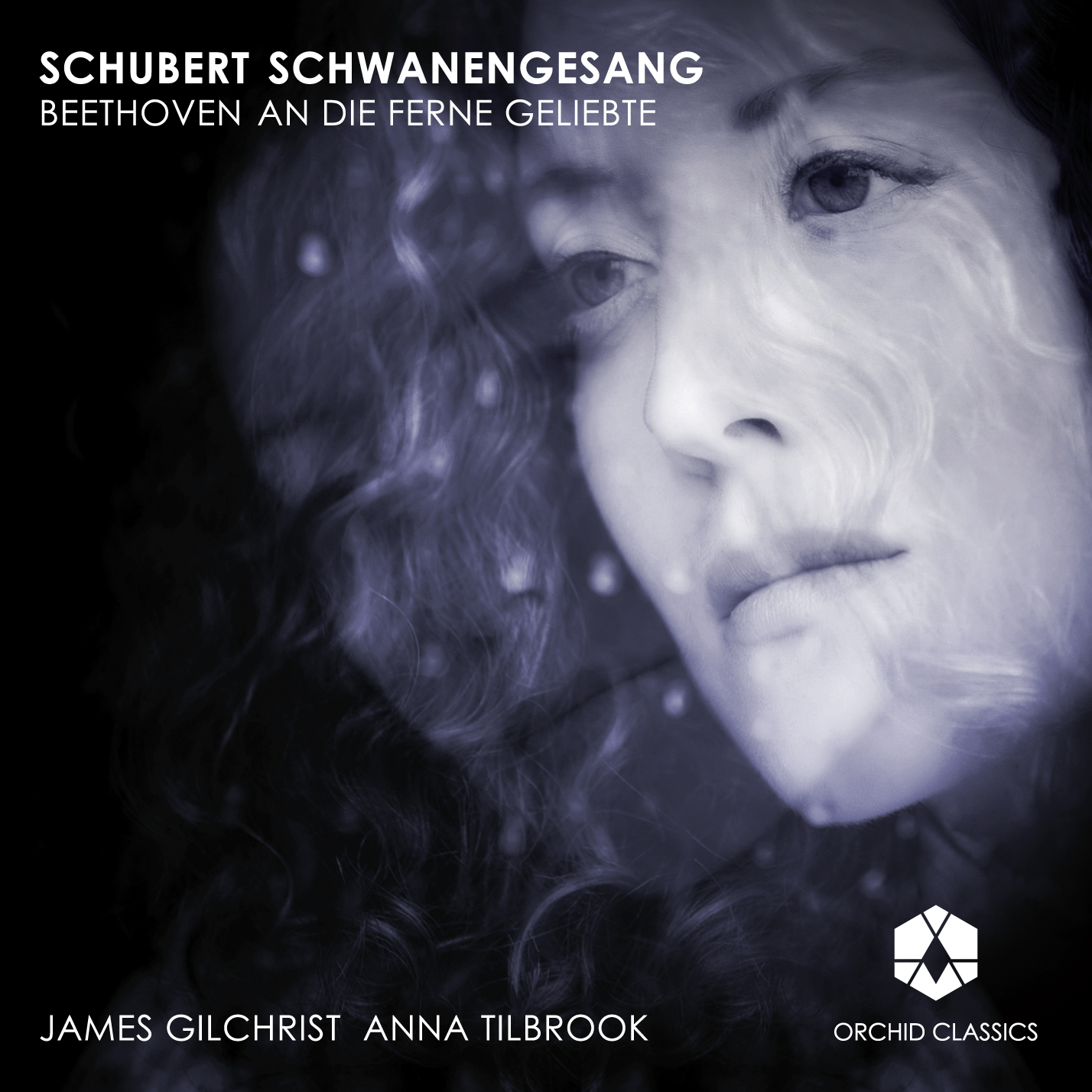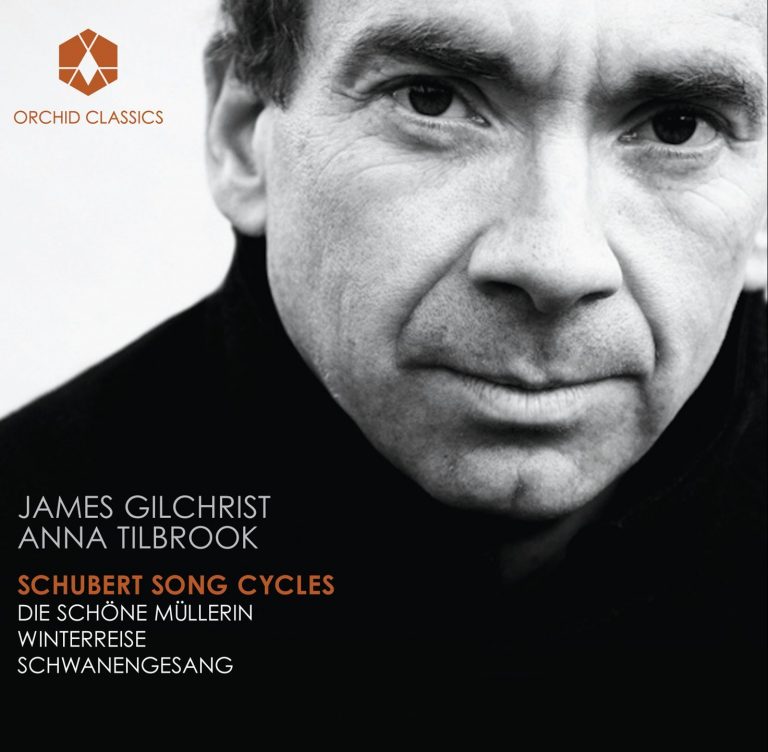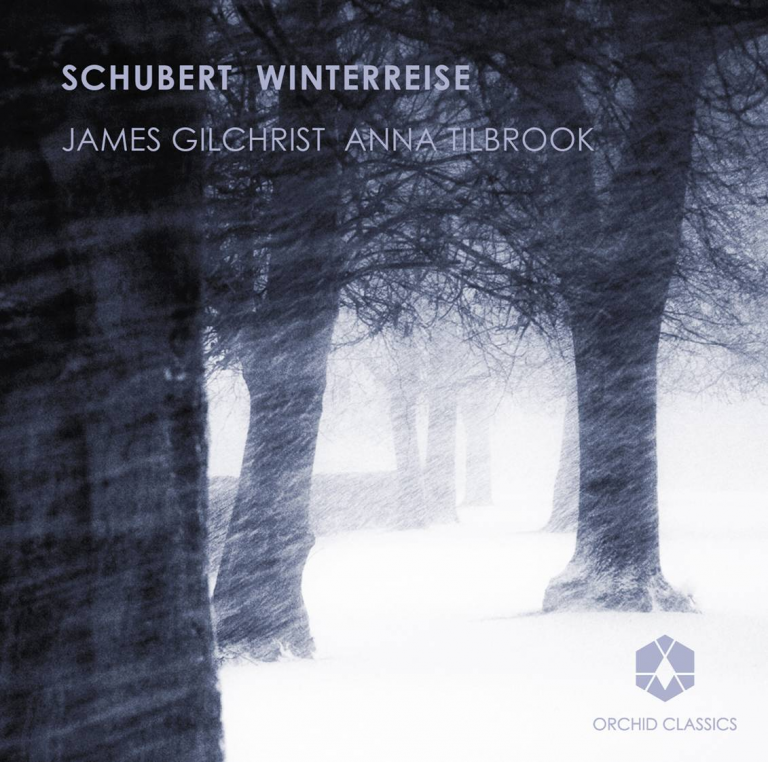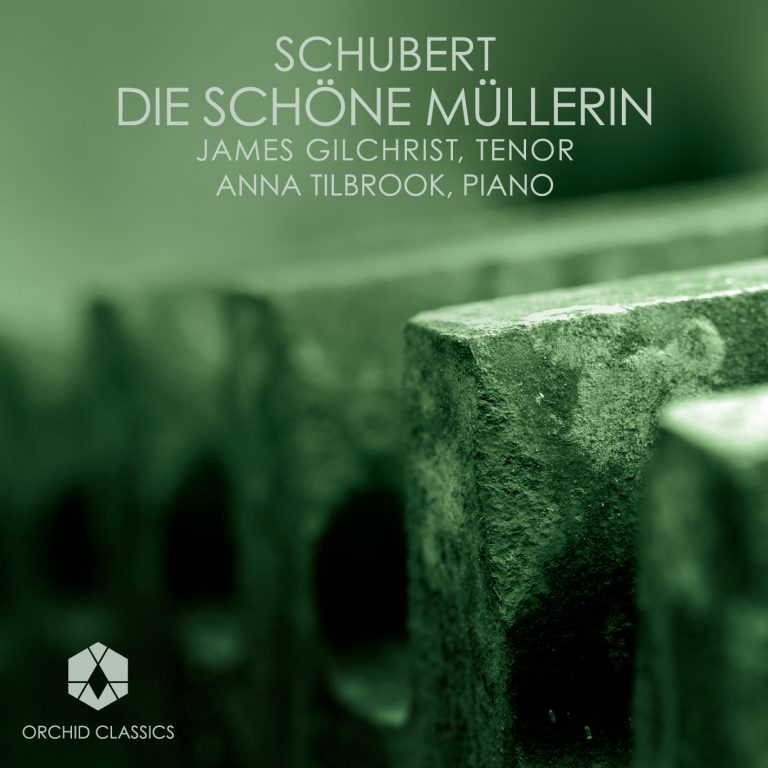Artist Led, Creatively Driven

Schubert Schwanengesang
James Gilchrist, Anna Tilbrook
Release Date: October 2010
ORC100013
LUDWIG VAN BEETHOVEN (1770-1827)
An die ferne Geliebte, Op.98
Auf dem Hügel sitz ich spähend
Wo die Berge so blau
Leichte Segler in den Höhen
Diese Wolken in den Höhen
Es kehret der Maien, es blühet die Au
Nimm sie hin denn, diese Lieder
FRANZ SCHUBERT (1797-1828)
Schwanengesang, D957
Liebesbotschaft
Kriegers Ahnung
Frühlingssehnsucht
Ständchen
Aufenthalt
In der Ferne
Abschied
Der Atlas
Ihr Bild
Das Fischermädchen
Die Stadt
Am Meer
Der Doppelgänger
Die Taubenpost
James Gilchrist, tenor
Anna Tilbrook, piano
I have known An die ferne Geliebte for a long time. I remember giving a (doubtless terrible) performance while I was still at school. It was one of the first works of the song repertoire that I properly learned and got to know, and it was this astonishing piece that first opened my eyes to the delights that the form can offer. It feels to me like a work in miniature, despite its length. There is something incredibly delicate about it, and a lightness of touch that feels almost reverential. It’s so beautifully crafted, with a restless, youthful excitement maintained through the gentle accelerandi between movements and a wonderfully satisfying symmetry of first and last movements in the warm, comfortable key of E flat. I feel the emotional heart of the work lies less in the pain of separation than in the suspended moment of hushed worship in ‘Wo die Berge’. The delight at witnessing the springtime business of pairs of swallows is only momentarily darkened by heartache. These pangs of separation are never overindulged, never allowed full rein. Always tempered, and held in check. The poet is almost at a distance from himself. Perhaps the truth is that he allows himself a little hope that the power of these songs to reunite the lovers will prove more than metaphorical. Compare the last song of Schumann’s Op.24 (Heine) cycle, ‘Mit Myrten und Rosen’, where the gazing of the girl’s eyes on the letters in the book of poems is clearly as close as the poet’s ever going to get. The Beethoven feels subtly different: here, perhaps, we can enjoy a little the pain of a parting, for we feel one way or another it won’t be for very much longer.
Anna and I have performed this work many times over the years, and it feels a perfect pairing for Schwanengesang. Not just because of the lovely connection through the Rellstab poems – Schubert quite likely using the very manuscript of the poems which Beethoven had studied and marked for setting – but also in spirit. After the tortured passion of the Rellstab and the darkness of the Heine, in ‘Die Taubenpost’ the master of song and song cycles seems to capture again the lightness with which his hero Beethoven had illuminated the very first song cycle of all.
The collection of songs that has been loved for nearly 200 years as Schubert’s Schwanengesang seems to me to show Schubert at something of a turning-point in his artistry as a song-setter. Of course, it’s his last collection, and so it’s probably only my imagination, but it feels to me that in the settings of Heine, Schubert is finding a brand-new voice: he’s found in these distilled poems of his contemporary an inspiration to deal in a new way with the craft of song-setting. The Rellstab and Heine sets are so strikingly different: Rellstab with much more wordiness, long sentences with strained syntax, evokes a thicker, notier voice from Schubert. Somehow these jewels of song seem to flow. Schubert is at the height of his powers and his melodic genius is pouring forth. With the striking bare visual imagery of Heine, he finds a bolder brush-stroke, a more impressionistic setting and a breathtaking daring to be spare: ‘Die Stadt’ is almost written on one chord, ‘Am Meer’ scarcely moves. It’s tremendously exciting to perform: the raw emotional intensity allows you to dare to be ugly in tone; you can almost feel the weight of the world on Atlas’ shoulders; the shock of the deathly pallid face in ‘Der Doppelgänger’ is theatrically given.
It’s so easy to see Schwanengesang (the title doesn’t help, of course) as a work associated with end of life, with old age, even. But Schubert was young, the poets the same or younger. All the songs seem to show how much more there is to come and how much more Schubert has to say. Fate, of course, had other ideas and cut him off in his prime: experimental, daring and full of youth and hope in the future.
James Gilchrist © 2010
An die ferne Geliebte is widely considered to be the first ever song cycle – it was certainly the first time that a major composer had organized a group of songs with piano accompaniment into a coherent whole. The theme of the distant beloved, however, had loomed large in Beethoven’s Lieder a long time before the composition of his only cycle: ‘Adelaide’ (1794-5), ‘An den fernen Geliebten’ (1809), ‘Lied aus der Ferne’ (1809), ‘Andenken’ (1809), ‘Der Jüngling in der Fremde’ (1809), ‘Sehnsucht’ [‘Was zieht mir das Herz so’] (1810) all deal specifically with the theme of separation before Beethoven wrote his celebrated letter to ‘The Immortal Beloved’, which dates from July 1812. Although An die ferne Geliebte was composed four years after that tortured outpouring, there is enough evidence to suggest that he was still obsessed by the unknown woman, and that the cycle was an attempt to banish her from his mind. A month after its composition Beethoven confided to Ferdinand Ries, his intimate composer and pianist friend, that he had found ‘only one woman whom I shall doubtless never possess’; and Fanny Giannatasio del Rio, whose father owned the boarding school which Beethoven’s nephew attended in 1816-18, confided to her diary on 16 September 1816 a conversation she had overheard between her father and Beethoven, who confessed how he had become acquainted with a person, ‘a more intimate union with whom‘ he would have considered the greatest happiness of his life. It was however not to be thought of, it was almost impossible, a chimera. ‘ I have still not been able to banish it from my mind‘ were the Beethoven words that affected Fanny most profoundly.
Whatever the truth of Fanny’s diary entries (scholars have usually considered them to be transparently honest), it is clear that Beethoven at the time of An die ferne Geliebte was still obsessed by some powerful, unconsummated relationship – and he was still to compose two more songs on precisely the same theme: ‘Ruf vom Berge’ (December 1816) and ‘Gedenke mein’ (1819-20). It seems very likely, moreover, that the poems of the cycle were written expressly at Beethoven’s request. Since no evidence of collaboration between composer and poet has come down to us, we can only guess at what might have happened. Alois Jeitteles (or Aloys Jeiteles) was a doctor by profession, not a poet. He was born in Brno in 1794, and his medical studies took him to Vienna, where he wrote some poems for Ignaz Castelli’s anthology Selam (1815), the same publication which provided Schubert for some of his songs. Though his poems appeared in several almanacs, they were never published in book form, and Beethoven was probably delighted to have found a virtually unknown collaborator who was not only musical and cultured but almost certainly willing to be directed. Each of the six poems is dominated by the image of the distant beloved. ‘Auf dem Hügel sitz ich spähend’ tells us of their first meeting (‘in the distant meadows’) and their subsequent separation which, we are told, is a torment (‘Qual’) to both of them. ‘Wo die Berge so blau’ expresses the poet’s obsessive wish (the ‘wo’ is mentioned four times) to be by her side. His reverie is banished in the next song, ‘Leichte Segler in den Höhen’, in which he begs the scudding clouds, rippling brook and gusting breeze to convey to her his longing. The same idea (and the same key) is continued in ‘Diese Wolken in den Höhen’ which contains the only sensuous phrase in the cycle that describes the breeze frolicking about her cheeks and breast and burrowing in her silken locks. All these fond imaginings, however, vanish in the fifth song, ‘Es kehret der Maien, es blühet die Au’, as the poet comes down to earth with a bump, and the joy of all nature (especially the conjugal bliss of the swallow) is contrasted with the barrenness of his own love, which leads him to conclude in ‘Nimm sie hin denn, diese Lieder’ – with a mixture of reverence and stoicism – that only through his poetry will he be at one with the object of his desire.
Schwanengesang was the title invented by Tobias Haslinger when he published 14 of Schubert’s late songs in the spring of 1829: seven settings of Ludwig Rellstab, six of Heinrich Heine and one of Johann Gabriel Seidl. Schubert had already offered the Heine group as a self-contained set to the Leipzig publisher Probst. There is good evidence, however, that he eventually wished the Rellstab and Heine groups to be performed together – the autograph in the Pierpont Morgan Library includes all 13 songs, and Spaun mentions in his memoir of the composer that these last songs were to be dedicated to his friends and published by Haslinger. Though the autograph of Seidl’s ‘Die Taubenpost’ did not form part of either group, the song has proved irresistible since its first performance, and is sorely missed when omitted by Schwanengesang purists.
Ludwig Rellstab, two years younger than Schubert, was active in Berlin as literary critic, dramatist, novelist, poet and librettist. He had originally offered his poems to Beethoven, who died before he could set them to music, but not before he had studied the poems in detail, as this extract from Rellstab’s memoirs makes clear: ‘A few had been marked with pencil, in Beethoven’s own hand – those which he liked best and had then passed on to Schubert to set, since he himself felt too ill … It was a moving experience to receive back the manuscripts which had travelled a route so strange, yet so fruitful for Art, before they returned to me.’
Schubert’s source, then, was almost certainly the annotated manuscript that Beethoven’s secretary, Anton Schindler, had provided for him after Beethoven’s death. It must have been a wonderful thrill for Schubert to handle the very manuscript pages of Rellstab’s poems that Beethoven had consulted and marked in pencil. Beethoven’s An die ferne Geliebte (To the Distant Beloved), published in 1816, had made an immediate impression on Schubert, who was soon trying his own hand at the cycle form, in emulation of his great hero. All the seven Rellstab poems from Schwanengesang have the distant beloved as their central theme; and it seems more than likely that Schubert, when after Beethoven’s death he received the portfolio of Rellstab poems, wished to impose order on the random selection by choosing poems that, though free-standing, were united by this common theme, thus forming a tribute to the composer of An die ferne Geliebte.
The poets of both ‘Liebesbotschaft’ and ‘Leichte Segler in den Höhen’ from Beethoven’s cycle beg the brooklet (the surrogate lover, as in Die schöne Müllerin), to convey greetings to the beloved. The song begins, like ‘Wohin’, in G major, and then passes through E minor, C major, A minor, F major and B, as though Schubert wished to illustrate the distance between the lovers by the multiplicity of keys: the rippling semiquavers might provide a formal unity to the song, but the lovers remain apart. ‘Kriegers Ahnung’, on the other hand, has no such formal unity and adopts instead a sectional structure. It begins with nine bars of muffled drums, as we are introduced to the soldier who, billeted with his comrades on a battlefield, dreams of his beloved in the knowledge that his imminent death will prevent them ever meeting again – the conclusion we must draw from the five times repeated ‘Herzliebste, gute Nacht!’ In ‘Frühlingssehnsucht’ it is the whispering breezes that initially become the medium for the poet’s message to his distant beloved. The difficulty facing Schubert was to find an accompaniment that would also fit the imagery of the four subsequent verses, in which babbling brooks, sunlight, bursting buds, and longing are requested to act as the poet’s messengers – a problem Schubert solved with his ubiquitous triplets. The poem ends with a passionate question and answer: ‘Who shall finally quell my longing?/Only you can set free the spring in my heart,/Only you!’. Though the poet’s ‘Nur du!’ is repeated four times, the last two to an ff dynamic, there is no final flourish; instead the broken B flat major chords limp to a close with a suggestion of E flat minor, as we realize that the poet is alone.
A similar melancholy informs ‘Ständchen’, the most celebrated serenade in all music. Schubert’s irresistible tune has led some singers and pianists to perform the song as euphorically as possible – but that is to misunderstand the poem, the music and the theme of these Rellstab songs. The song might begin brightly enough with staccato quavers that suggest a plectrum-plucked guitar (they only appear in the four-bar prelude, but the staccato marking should be observed throughout), the key, however, is minor and all four verses are touched with a sense of vulnerability – verse three in particular with its mention of nightingales which, traditionally, sing about unhappy love and not its fulfilment. There is an abrupt change of mood and rhythm at ‘Lass auch dir die Brust bewegen’, but the singer’s macho confidence is a sham; and though the thrice repeated ‘Komm, beglücke mich!’ suggests sexual union (especially when voice and piano combine in triplet thirds during the first repeat of the phrase), it loses all sense of conviction in the final repetition and peters away in a heartbreaking decrescendo, as the singer realizes how unattainable his beloved has become.
Though ‘Aufenthalt’ is the only one of the seven Rellstab settings in which there is no mention of love, the distant beloved seems present in every bar of this anguished outpouring in which the outcast and fugitive expresses his torment in E minor, Schubert’s key of sadness and depression – as in ‘Wasserflut’ from Winterreise and ‘Trockne Blumen’ from Die schöne Müllerin. The song is marked Nicht zu geschwind, doch kräftig. By the next song, however, ‘In der Ferne’, all sense of vigour and defiance has vanished; we are confronted with an emotional wreck, although, because of the poem’s deliberately contorted syntax, it is only in the final stanza that we learn how the poet had been talking of his own plight. There he describes how his beloved has broken his heart and how he must now leave her. The torment had been present from the obsessive opening bars of the prelude which rise and fall a semitone in B minor – the key of ‘Der Doppelgänger’. The poet’s distressed and depressed mental state is wonderfully conveyed by Schubert at the end of the first verse where the vocal line plunges a fifth on the repeated ‘Wegen nach’ (‘No blessing follows him on his way’). Though the song ends in a fortissimo crescendo, the final ffz tells us that there can be no solace or cure.
In ‘Abschied’, the lover has recovered sufficiently to control his grief. The song is marked Mäßig geschwind, which means that he does not leave the town at breakneck speed, as some singers and pianists insist. Nor is this a merry farewell. The last verse, in particular, is full of foreboding – the stars are commanded to ‘veil themselves in grey’, and the jilted lover tells us that he has been forced to leave the town: ‘Darf ich hier nicht weilen, muss hier vorbei’ – the italics are Rellstab’s. The present has become unbearable. As if to stress the impossibility of remaining in her town, Schubert sets the key word ‘Ade’ in virtually every part of the vocal register, as seconds, thirds (ascending and descending), fourths and sixths hammer home the irrevocable rift.
The Heine songs from the Schwanengesang manuscript follow on from the Rellstab settings. ‘Der Atlas’ calls for a dynamic range from pp to fff to express the suffering of Atlas, who fought for the Titans against Zeus, was defeated and condemned to carry the weight of the world on his shoulders. The bleakness of ‘Ihr Bild’ is achieved in a mere 36 bars – a distillation of despair conveyed by bare octaves and a modulation at ‘ihre Lippen’ from B minor to G flat major that provides an illusory solace which is immediately dashed as minor reasserts itself. ‘Das Fischermädchen’ is not the blithe barcarolle it is sometimes claimed to be. The abrupt shift from C flat to B flat in stanza two and the repetition of the final word of each verse as a slurred seventh successfully convey the irony of Heine’s verse. The short prelude of ‘Die Stadt’ repeats in the bass the bare octaves of ‘Ihr Bild’, while the scurrying diminished sevenths of the right hand 17 times convey the gusting wind – without resolution. A lonely low C on the piano brings the chilling song to a close. The serene diatonic opening of ‘Am Meer’ is followed by a tormented, chromatic stanza whose tremolando chords depict the rising tide, the mist and the grief. Heine’s bitter last line is caught to perfection by Schubert’s slow ironic turn on ‘Tränen’. The same device closes ‘Der Doppelgänger’, the bleakest song – or rather declamation – in Schubert. As in ‘Der Atlas’, the dynamic range required is from pp to fff. The resemblance between the four-note theme of the opening bars to the Agnus Dei of Schubert’s E flat Mass, composed in June of the same year, tells us which way Schubert’s thoughts were turning. His art, with this intensely dramatic declamation, was turning prophetically towards Wagner and Wolf.
The final song of Schwanengesang, ‘Die Taubenpost’, must, like many of his Lieder, have been set from manuscript, since it does not appear in the two volume edition of Seidl’s verse that was published in l826. No song of Schubert’s demonstrates better his delight in life and the bitter-sweet magic of his melodies. The song, Schubert’s last, was composed in October 1828; a month later he was dead.
Richard Stokes © 2010
JAMES GILCHRIST
James Gilchrist began his working life as a doctor, turning to a full-time music career in 1996.
Concert appearances include Britten Serenade for Tenor, Horn and Strings (Manchester Camerata, Douglas Boyd), Haydn The Seasons (BBC Proms, St Louis Symphony, Sir Roger Norrington), Tippett The Knot Garden (BBCSO, Sir Andrew Davis), Bach Christmas Oratorio (Tonhalle-Orchestra Zurich, Ton Koopman), Bach St Matthew Passion (Royal Concertgebouw Orchestra, Sir Roger Norrington), Handel Belshazzar (Philharmonia Baroque, Nicholas McGegan), Stravinsky La Pulcinella (Orchestre National de Paris, Thierry Fischer) and Handel Athalia (Concerto Köln, Ivor Bolton).
As a recitalist, he has appeared at many venues throughout the UK, in New York, and at the Amsterdam Concertgebouw. In his partnership with the pianist Anna Tilbrook his performances include many broadcasts for BBC Radio 3, performing Schumann cycles and Schubert songs, as well as demonstrating a special interest in English song, with broadcasts of Finzi, Vaughan Williams, Robin Holloway, Tippett and Britten. James is also partnered regularly by the harpist Alison Nicholls, with whom he has performed songs by the contemporary English composers Alec Roth, Howard Skempton (both recorded on Hyperion) and Nicola LeFanu.
Amongst his many recordings are the title role in Britten Albert Herring (Hickox), Bach St Matthew Passion (McCreesh), Bach Cantatas (Gardiner, Koopman and Suzuki), ‘Oh Fair to See'(the complete songs for Tenor and Piano by Gerald Finzi), Vaughan Williams On Wenlock Edge (finalist in the 2008 Gramophone awards) and Britten Owen Wingrave (Hickox). Recent and forthcoming releases include songs of
Lennox Berkeley (Chandos), Britten Winter Words and Leighton Earth, sweet Earth (Linn) and a ground-breaking new recording rediscovering the work of the early 20th century composer Muriel Herbert (Linn).
ANNA TILBROOK
Born in Hertfordshire, Anna Tilbrook studied music at York University and with Julius Drake at the Royal Academy of Music in London, where she was a major prize winner. She has quickly become one of Britain’s most exciting young pianists, with a considerable reputation in song recitals and chamber music, having made her debut at the Wigmore Hall in 1999. She has collaborated with such leading singers as James Gilchrist, Lucy Crowe, Sarah Tynan, Willard White, Barbara Bonney, Mark Padmore, Stephan Loges, Ian Bostridge and Gillian Keith. For Welsh National Opera she has accompanied Angela Gheorghiu, José Carreras and Bryn Terfel in televised concerts, and over several years has been associated with the Two Moors Festival in Devon, programming comprehensive surveys of the song cycles of Schubert, Schumann and Mahler. Enjoying partnerships with a number of instrumentalists, she has performed Messiaen’s Quatuor pour la fin du Temps at St David’s Hall, Cardiff, and with the Fitzwilliam String Quartet has played chamber music by Shostakovich, a chamber arrangement of Mozart’s Piano Concerto, KV 415 and Elgar’s Piano Quintet throughout the UK. Recently she has given recitals at LSO St Luke’s, the Three Choirs Festival, Oxford Lieder Festival, and the festivals Wratislavia Cantans in Wroc?aw and Anima Mundi in Pisa. In 2006 Anna Tilbrook made her conducting debut at the Buxton Festival directing Telemann’s Pimpinone from the harpsichord.










